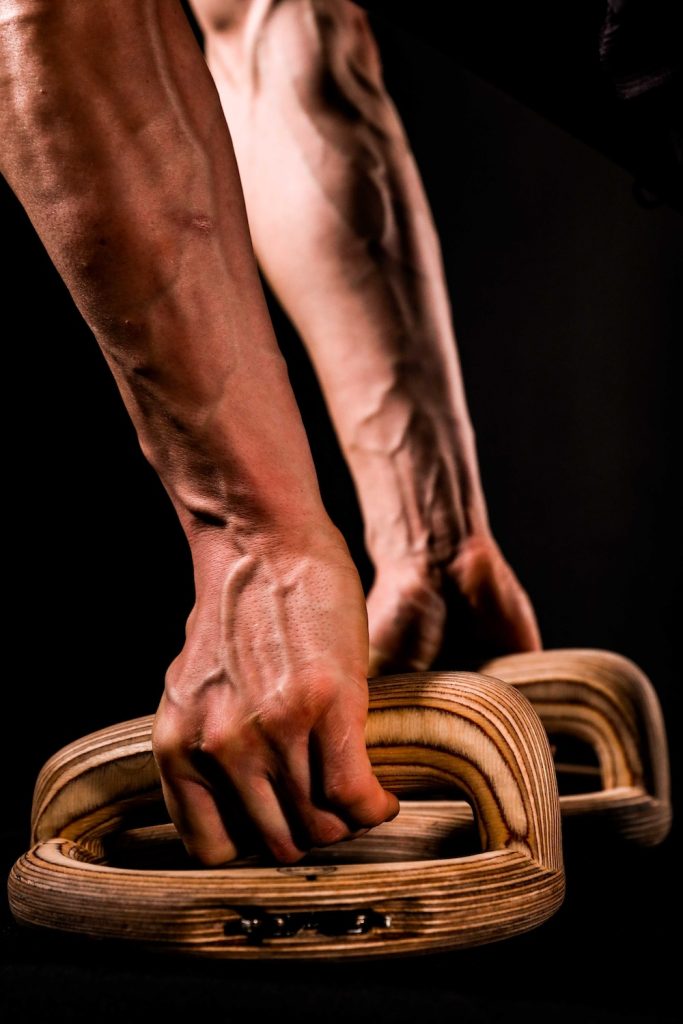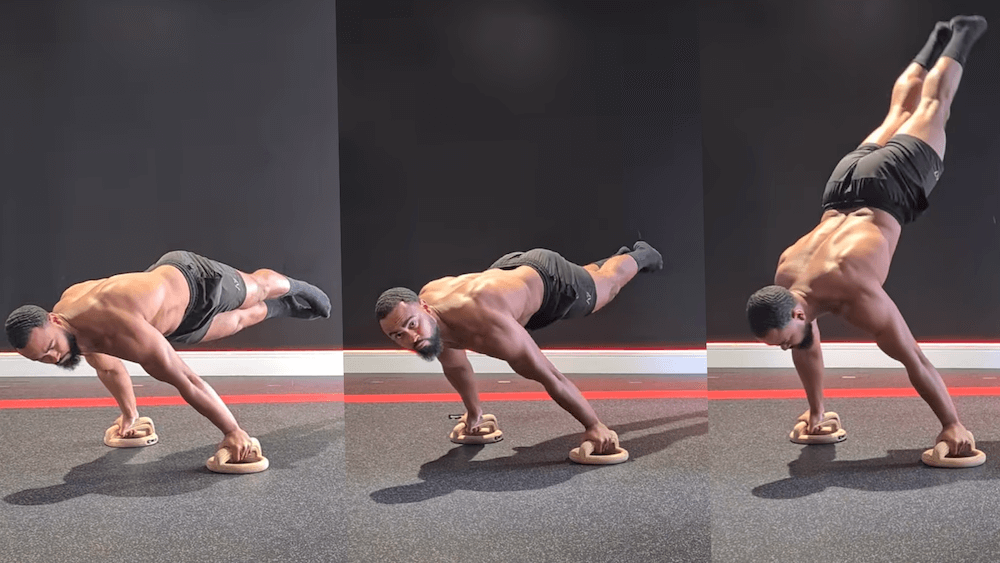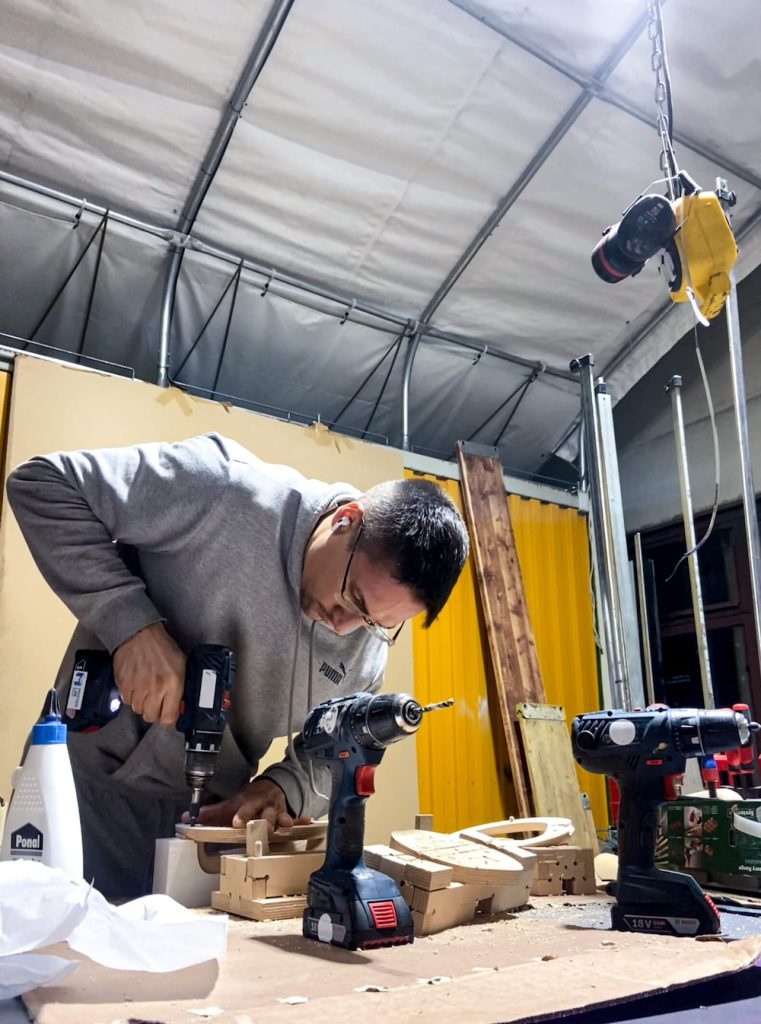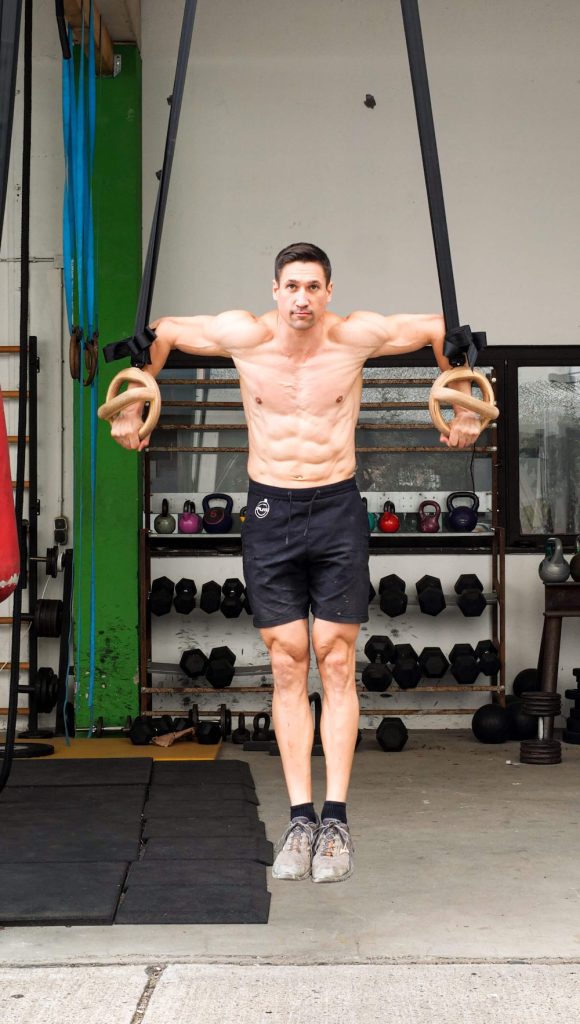Ever wondered, what would the offspring of a gymnastics ring and parallette look like? Yeah, we neither. BUT the child was born, and it’s beautiful…Meet the CALIRING!

What is CALIRING and how is it different?
At first sight, the CALIRING looks very similar to the gymnastics rings, although it has some significant and some subtle improvements.
The biggest difference between gymnastics rings and CALIRING is the diagonal handle that is attached to the ring itself. This has the function of parallettes with one difference - it has a slight slope for improved wrist position when doing planches on the ground. The thickness of the handle and the rings seemed to be identical. It’s very nicely finished and comfortable to grip.

On the ground, when set up for planche, the ring provides an extremely stable platform and is much less straining for the wrists compared to a straight bar. For handstands, I think I would still prefer the latter but I’m sure it’s just a matter of getting used to.
One less obvious but very useful feature Ben built into CALIRING is the fast-release buckle design that attaches the strap to the CALIRING on the top. That’s right, no more ring rash on your skin from the straps - which you probably accepted as a given when exercising with traditional gymnastics rings.
If you lack space at home or want to be a minimalist by packing two calisthenics equipment into one then CALIRING is a great alternative to have the function of a parallettes and gymnastics rings in the same package.
Meet the founder of CALIRING
The founder and inventor behind CALIRING is Benedikt Freiherr Taets von Amerongen whom I had a chance to meet in his workshop in Berlin, Germany. After a good training together Ben showed me around the production facility, then we sat down to discuss the inspiration behind the new design.
Read on to get to know Ben and the story behind CALIRING from our interview.
Interview with Ben, the inventor of CALIRING

What exactly is the difference between CALIRING and the gymnastics ring?
CALIRING is a revolutionized version of the classic workout rings and parallettes, combining them to create one simple yet efficient exercise device, which is multifunctional and ergonomic to train all hanging and floored exercises with one device.
CALIRING has multiple patented features, such as an inside wood lock, so the strap is attached to the middle of the upper part of the torus, simulating a fixed gymnastics ring (which is also fixed at the top), but it is designed, so that the strap can’t rub your forearm skin, reducing injuries. The strap is connected with a quick-release buckle so that you can detach CALIRING quickly to the strap and use it efficiently for fast pull+push combos like row+pushup for example. The strap is made of the same material as a car seat belt, providing an improved slide sensation to the skin, when contact is made, for example, if you have large biceps, then in the ring dip there will probably be a contact at your upper arm.
CALIRING has an ergonomic 7-degree angled grip which favors the wrist position for pressing exercises on the floor, especially push-ups and all sorts of forward-leaning pressing exercises such as the planche. Furthermore, you can turn it around and use the middle handle as a balancing component to work your deep muscle tissue combining balance + pressing exercises on the floor.
Where is Caliring produced and by whom?
At the moment all CALIRINGS are handmade by myself here in a coworking space, called MotionLab in Berlin (it’s a makers’ space and accelerator for startups developing hardware products).

What are some exercises that are better to perform with CALIRING and why?
All sorts of dips, but especially Bulgarian Dips are much more ergonomic using CALIRING, as there is no more strap rubbing over your forearm skin. Furthermore, people with wrist problems feel much safer using CALIRING for all sorts of pulling exercises such as rows, hanging, and pullups as they can grab the angled handle from the inside and rest their wrist on the under half of the torus. This way also beginners can start their pulling training in a wrist-friendly way, without being forced to grab their full weight at once.

All floor pressing exercises are more wrist-friendly due to the angled design which follows the wrist structure. Also, the variety of sliding floor exercises is gigantic, as it has a wooden surface you can slide on wood, tiles, carpet, etc… and make all sorts of pushup variations.

The circular force transmission from the handle to the ring maximizes the stability on the floor. So all kinds of explosive / jumping exercise such as explosive push-ups or burpees become not only better for the wrist position but also guarantees a safe landing, to avoid wrist twist-related injuries.
CALIRING is excellent when you want to travel and carry only one multifunctional training device with you.
Ben from Caliring

Explain to us the design iterations that lead you to the current version of CALIRING. What worked, what didn’t work?
I am a Designer, so having constant chaos in my head about ideas to solve problems is equally wonderful and painful at the same time. The current model is iteration #178 and the number of designs in CAD I made, without testing it in the physical world is close to 1.000, my brain just never stops thinking about what could be made better, further improved, and so on…

However, I love what I do and it fulfills me with great joy seeing a person using my product. As a product designer, it felt audacious to me even thinking about redesigning a gymnastics ring. I mean it is a “perfect” design, with strong and homogenous tours held by a band and used for over 100 years in professional gymnastics. However, even if something is used for a very long time and proven to be effective, there is always a possibility for advancement.
So I first started in July 2021 thinking about improving the standard gymnastics ring, because I had intense forearm bruises on my skin from rubbing over the strap on the standard pair of gymnastics rings, which I had installed during the Covid lockdowns 2020/2021 at my apartment's ceiling for training. I trained mainly Bulgarian Ring Dips and Ring Push-up variations and remember the upset when again the forearm skin ripped open from rubbing over the strap and left my skin with bloody bruises.
I searched online for solutions and found multiple forums with athletes discussing the same problem. Several options were recommended such as cutting a pair of socks to just wrap it over the arms or buying a pair of arm sleeves. None of the solutions I was happy with, as I found them extremely unaesthetic.
I didn't want to buy some additional equipment and simply wanted to continue my training shirtless to analyze my movement pattern to improve my technique. One comment stuck with me as a person wrote “just suck it up, buttercup” as a product designer, I felt immediately that there is a problem to be solved.
However, not happy with the results I just took a multitool and cut a slot through the upper part of my rings to guide the straps through so I had no more worry about the strap rubbing to the forearm skin and could enjoy my training again with this first prototype for quite some time. But I still wasn't really satisfied with the solution, as it was more of a fast improvement but no real solution to the strap connection problem.
I took the idea further and designed the first ERGORING on my 3D printer to test it at my favorite calisthenics place. Happy with the result of my first set of 5 x 15 kg Bulgarian Dips without any forearm bruises I advanced the design and tested various methods on how to pull the strap through the upper torus until I was sure to have the best design.

One late night, analyzing my footage when I compared my forearm movement to identify where the exact contact position of the forearm skin to the torus is and how it behaves in different movements, I realized that there is a major unused area in the ring that is never used. I call it the dead area and almost 70% of the ring is covered by that and therefore never touched, regardless of which exercise.
It makes total sense in hindsight as your wrist only grabs a “wrist wide area” of the lower part of the torus, but at that moment I realized it for the first time. So I started thinking about how to make more efficient use of that lost area, or how to change the whole design again and tested various further shapes.
Then the idea came to me that the arc that holds the band away could be bent higher upwards so there is no constraint to the ring exercises as it travels only in the dead area of the ring but then it allows it to be used as a fixed wrist grip for floor exercises.
Ben from Caliring
I advanced some design iterations and produced glass fiber and later carbon fiber reinforced rings with the new handle design. I was so happy with that multifunction and wanted to see what others thought about it.
The first real test I did was with a great group of calisthenics enthusiasts named “SCHUBBARS” in Dortmund and we tested the first models with a group of athletes. I was very satisfied with their feedback, as they approached me and told me they had never seen anything like the ERGORING and I began to gain confidence in my idea.
However, I was still at my tiny apartment in Dortmund and imagined I needed a garage kind of space, contacts to engineers, and more time and also money to work full time on the product. I still had to develop a better mechanism for the strap attachment as of now it was just not efficient to use and I had only a raw vision but couldn't develop it any further at home with my limited tools and space. So I researched and found a great maker space in Berlin and in March 2022 I moved to Berlin to throw everything I had into the next iteration of the product and was very happy with the next results, but still not fully satisfied. So I applied for an accelerator program and luckily got my spot.
Where can people try CALIRING?

Come to our weekly CALIRING training classes every Wednesday, 6:00 pm, at MotionLab in Berlin, where I introduce you to the product, showing you what exercises you can do and how to adjust to your level. No worries, beginners are welcome as well as advanced athletes. The best thing about training with your body weight is that you can adjust it to your level.
When and how can people buy CALIRING?
You can support CALIRING on Kickstarter and later purchase it at CALIRING Shop. Also, please send me an image/text/logo/… whatever motivates you, which I then laser engrave to personalize your own CALIRING.

I want to thank Ben for the great chat and wish him all the best with the project! In the meantime, make sure you give CALIRING a follow on Instagram.



